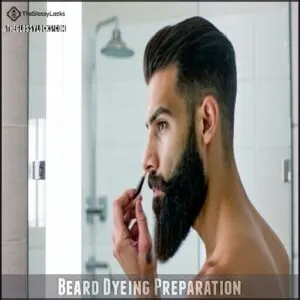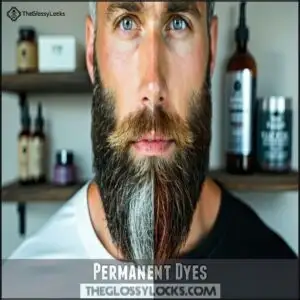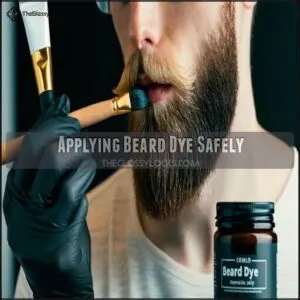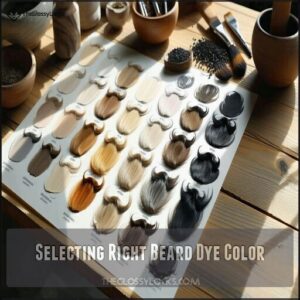This site is supported by our readers. We may earn a commission, at no cost to you, if you purchase through links.

Wash and dry your beard to remove oils, then apply petroleum jelly along the edges to protect your skin.
Mix the dye as directed and use an applicator or toothbrush to coat your beard evenly. Keep an eye on the color as it develops, typically 10-15 minutes, and rinse with cool water when satisfied.
Use a color-safe shampoo to lock in the shade. For maintenance, reapply every few weeks and keep your beard moisturized with oil.
Want a natural option? Henna might surprise you!
Table Of Contents
- Key Takeaways
- Beard Dyeing Preparation
- How to Color Your Beard
- Choosing Beard Dye Type
- Applying Beard Dye Safely
- Dyeing Techniques and Tips
- Beard Dye Aftercare and Maintenance
- Selecting Right Beard Dye Color
- Maintaining Colored Beard
- Frequently Asked Questions (FAQs)
- How do you dye a beard?
- How do I choose a beard color?
- How do I choose a beard hair dye?
- Can You dye a beard white?
- Should I dye my beard light or dark?
- Can a beard dye match your natural color?
- How long does colored beard dye last?
- How often should I re- dye my beard?
- What are the possible side effects of coloring my beard?
- Is it safe to use beard dye on sensitive skin?
- Conclusion
Key Takeaways
- Choose a beard dye that matches your natural shade or desired look, and always do a patch test 48 hours before applying.
- Wash and dry your beard thoroughly, skip conditioner, and use petroleum jelly to protect your skin during application.
- Apply the dye evenly with a brush or toothbrush, monitor the color as it develops, and rinse with cool water to lock it in.
- Maintain your beard color with a color-safe shampoo, reapply every few weeks, and use beard oil to prevent dryness.
Beard Dyeing Preparation
Before you start coloring your beard, make sure it’s thick enough for even coverage and growth.
Wash it thoroughly with shampoo, skip the conditioner, and dry it completely to prepare the hair for dyeing.
Waiting Period for Thicker Beard
Before grabbing that beard dye, give your growth phase some time—about 1-2 weeks.
Patience pays off—let your beard grow thicker for 1-2 weeks to ensure even, flawless dyeing results.
This allows your beard to hit the length threshold (1 inch) for better follicle density and dye effectiveness.
Patchy beards are harder to color evenly, so patience pays off.
Let your beard grow thicker and fuller to avoid uneven results and maximize your beard coloring success.
Washing and Drying Before Dyeing
Before beard coloring, wash your beard with shampoo to cleanse follicles and remove buildup—this guarantees even dye application.
Skip conditioner; it blocks dye absorption. Drying methods matter too—pat dry with a towel or air dry completely, as moisture can dilute the dye.
For oil retention, avoid overwashing beforehand. To protect against irritation, consider that pre-existing oils act as a natural barrier.
Proper beard prep sets the stage for flawless beard dye results.
How to Color Your Beard
When learning how to dye your beard, preparation and technique are key.
Start by performing a patch test 48 hours before to check for dye reactions, especially if you have sensitive skin.
Once you’re ready, follow these steps:
- Prep your beard: Wash it thoroughly and dry completely—skip conditioner to avoid color fading.
- Apply a barrier: Use petroleum jelly around the beard line to protect your skin.
- Mix and apply: Combine the beard dye and processor in a non-metal bowl, then apply evenly using a brush or toothbrush.
- Monitor and rinse: Watch the color develop, testing small sections until it’s just right. Rinse with cool water until clear.
Using beard oil after dyeing helps in maintaining beard softness. Be patient—mastering beard coloring takes practice, but the results are worth it!
Choosing Beard Dye Type
Choosing the right beard dye type depends on how long you want the color to last and your comfort with maintenance.
Pick a beard dye that fits your lifestyle—temporary for fun, semi-permanent for flexibility, or permanent for bold, lasting color.
From temporary options to natural alternatives, each type offers unique benefits to match your needs, with the key consideration being complete concepts that help in making an informed decision.
Temporary Dyes
Temporary beard dyes are perfect for quick changes or testing a new look.
They offer vibrant color with minimal stain potential and are easy to remove with regular shampoo.
Ideal for special occasions, these dyes last a few days, requiring frequent application for consistency.
You can find a wide array of options online, which makes them a great way to experiment with beard coloring.
Their short product lifespan makes them a commitment-free option for experimenting with different looks.
Semi-Permanent Dyes
Semi-permanent beard dye strikes a balance between commitment and flexibility.
It lasts 2-4 weeks, gradually fading with each wash, making it ideal for gray coverage or subtle changes.
With proper beard dye application, you’ll enjoy better color longevity.
Always patch test first to check for skin sensitivity.
Beard dye options are readily available online.
Reapply as needed, following beard coloring tips for even results and natural-looking coverage.
Permanent Dyes
Permanent beard dye offers long-lasting color, perfect for gray coverage and bold transformations.
Its chemical composition, including ammonia and hydrogen peroxide, guarantees deep penetration but comes with application risks like skin irritation.
Follow the beard dye process carefully to avoid mishaps, and consider purchasing beard dye products online for convenience.
While the color fastness is impressive, the long-term effects may include dryness, so moisturize regularly for healthy results.
Natural Alternatives
Why not try natural beard dye alternatives?
Henna benefits include a reddish-brown tint and healthier hair.
Coffee shades give a deep, rich color while nourishing your beard.
Beet juice and carrot juice add vibrant tones, while cinnamon tinge offers subtle highlights.
These natural ingredients, like indigo and bhringraj, are gentle and effective, making them perfect for sensitive skin.
Applying Beard Dye Safely
To color your beard safely, you’ll need to take a few simple precautions to protect your skin and achieve even results.
Wearing gloves, applying a petroleum jelly barrier, and mixing the dye properly are key steps to avoid irritation and mess, including achieving even results.
Wearing Protective Gloves
Wearing gloves is a must for beard dye safety. They prevent skin irritation and allergic reactions while keeping your hands clean.
Choose proper gloves with strong dye resistance.
- Opt for latex or nitrile glove material for durability.
- Make certain a snug fit to avoid slipping.
- Dispose of gloves immediately after use.
- Always prioritize irritation prevention during application to ensure proper gloves are used.
Applying Petroleum Jelly Barrier
Before you start applying beard dye, protect your skin with a petroleum jelly barrier.
Dab Vaseline along your beard line to prevent stains and irritation.
It’s a simple step that guarantees application precision and shields sensitive skin.
If you’re out of Vaseline, barrier alternatives like coconut oil work too.
Remember to perform a patch test to avoid allergic reactions.
Afterward, gently wipe off the jelly for clean edges post-dyeing, ensuring a smooth finish.
Mixing Dye and Processor
When mixing dye and processor, precision is key to avoid a patchy beard.
Use a plastic or glass bowl—metal can mess with the dye’s chemistry.
Follow these steps:
- Measure ingredients accurately for proper ratio.
- Add the processor before the dye for smooth mixing consistency.
- Stir until fully blended for activation.
- Avoid clumps during dye preparation.
- Use an applicator brush for even application.
To ensure the best results, it is crucial to follow the instructions carefully and maintain the right consistency throughout the process.
Dyeing Techniques and Tips
Mastering the right technique guarantees your beard looks even and natural. Use tools like an applicator or toothbrush, apply carefully, and monitor the color as it develops.
Using Applicator or Toothbrush
For smooth beard dye application, grab an applicator brush or an old toothbrush.
The bristle type matters—firmer bristles guarantee even dye distribution.
Use quick, controlled up-and-down strokes, focusing on full coverage while avoiding stains on your skin.
These beard dye tools make coloring facial hair precise and effective.
Mastering this stroke technique is key to achieving a natural, polished look.
Monitoring Color Development
Keep an eye on the dye setting time to avoid over-darkening.
Use a damp paper towel to gently wipe a small section and check the color depth.
If it’s not quite right, give it more time for gradual darkening.
This simple beard dye technique guarantees your beard color matches your expectations without surprises, always rely on patch test results for safety.
Avoiding Patchiness and Skin Contact
Avoid patchiness by guaranteeing even application with precise strokes using proper application tools like a brush or toothbrush.
Apply barrier creams or Vaseline around your beard line to protect skin.
Focus on dye consistency to avoid streaks, and for precision application, work in small sections and avoid overloading the brush.
These beard dye application tips guarantee smooth, professional-looking results without skin stains, ensuring a professional-looking finish.
Beard Dye Aftercare and Maintenance
Taking care of your beard after dyeing is essential to keep the color vibrant and your hair healthy.
Stick to cool water rinses and use color-protection products to prevent fading and maintain a polished look.
Rinsing With Cool Water
Cool water is your best friend when rinsing beard dye. It helps lock in the beard color while boosting dye removal efficiency.
Gently massage to prevent residue buildup, ensuring even color retention impact.
Skip hot water—it can strip the dye prematurely.
For effective post-rinse care, pat your beard dry with a towel instead of rubbing to avoid irritation.
Using Color-Protection Shampoo
A color-safe shampoo is your secret weapon for maintaining beard dye and preventing color fading.
Look for gentle shampoo ingredients, avoiding sulfates that strip color. Use a proper lathering technique—massage thoroughly but don’t overdo it.
Washing frequency matters; every few days is ideal. Product recommendations like Color Guard Beard Shampoo guarantee vibrant beard color while supporting healthy beard grooming and care, making it a key part of your beard care routine.
Selecting Right Beard Dye Color
Choosing the right beard dye color guarantees a natural and polished look.
Focus on matching your skin tone and hair undertones while starting with a shade slightly lighter than your natural hair color.
Considering Skin Tone and Hair Undertones
Understanding your skin tone and undertones is key to finding the perfect beard dye.
Warm undertones pair well with earthy hues like chestnut, while cool undertones shine with ash or charcoal shades.
Neutral tones? You’ve got options!
- Match your beard undertones to your skin tone palette.
- Avoiding clashes guarantees a natural look.
- Complementary colors enhance your features effortlessly.
Choosing Shade Similar to Natural Hair
When picking a beard dye, aim for a shade close to your natural color.
Reference colors on the packaging, but remember: lighter is better to avoid harsh results.
Black might seem tempting, but it rarely matches natural tones.
A patch test guarantees the dye complements your natural undertones.
Proper color matching keeps your beard looking natural, not painted, and ensures a natural tone that enhances your appearance.
Maintaining Colored Beard
Keeping your beard color fresh takes regular upkeep, but it’s easier than you might think.
Reapply dye every few weeks, use beard oil to lock in moisture, and avoid over-dyeing to prevent dryness or damage.
Reapplying Dye Every Few Weeks
To keep your beard color looking fresh, reapply beard dye every 3-6 weeks, focusing on root touch-ups.
Monitor growth to maintain color consistency, as facial hair grows quickly.
Adjust dye frequency based on your beard’s needs, ensuring gradual adjustment without over-dyeing, to achieve seamless beard color maintenance.
Regular reapplication helps beard dye men achieve a natural blend of new growth with the existing shade.
Using Beard Oil for Moisture
Beard oil is a must for post-dye care, preventing dryness and keeping your beard soft.
Choose oils like argan or jojoba for their ingredient benefits and dye compatibility.
Apply sparingly after rinsing, focusing on the tips and roots.
Regular oil application frequency—2-3 times weekly—ensures proper beard maintenance.
Stick to dye-friendly beard products to avoid color fading.
Avoiding Over-Dyeing for Brittle Hair Prevention
After using beard oil for hydration, focus on avoiding beard dye mistakes like over-dyeing.
Frequent applications can cause beard hair breakage and dryness. Stick to a proper dyeing frequency—every 3-6 weeks—and check product ingredients for harsh chemicals.
Opt for gradual changes in color, and if unsure, seek professional advice to prevent beard damage and maintain healthy beard care habits.
For best results, consider cleansing and conditioning the beard before dyeing to achieve a desirable color and prevent damage.
Frequently Asked Questions (FAQs)
How do you dye a beard?
Start by washing and drying your beard.
Apply petroleum jelly around edges, wear gloves, and mix dye in a non-metal bowl.
Use a brush to apply evenly, wait, rinse with cool water, and moisturize.
How do I choose a beard color?
Choose a beard color slightly lighter than your natural hair to avoid an overly harsh look.
Match your skin tone and undertones, and always patch test.
For bold shades, consider temporary dyes first.
How do I choose a beard hair dye?
Picking a beard dye is like finding the right tool for a job—match your natural hair color or go a shade lighter.
Opt for beard-specific dyes, avoid harsh chemicals, and always patch test first.
Can You dye a beard white?
Yes, you can dye your beard white.
Use a bleach-based dye to lighten it first, then apply a white toner or semi-permanent dye.
Always do a patch test and follow product instructions carefully.
Should I dye my beard light or dark?
A lighter shade avoids overly dramatic results and lets you gradually darken if needed.
Darker dyes can look unnatural or harsh, so it’s safer to build up the color over time.
Can a beard dye match your natural color?
Measure twice, cut once" applies here too—select a shade slightly lighter than your natural beard color.
This avoids over-darkening, ensuring a seamless match while enhancing your look.
Always patch test to confirm compatibility.
How long does colored beard dye last?
Colored beard dye typically lasts 2-6 weeks, depending on the type used.
Permanent dyes stick around longer, while semi-permanent ones fade with each wash.
Regular care with color-safe products helps maintain vibrancy and longevity.
How often should I re- dye my beard?
Re-dye your beard every 3-6 weeks to maintain the color, focusing on roots as they grow quickly.
For gray coverage or semi-permanent dyes, touch-ups every 2-4 weeks might be needed for consistency.
What are the possible side effects of coloring my beard?
About 10% of people experience skin irritation from beard dyes.
You might face redness, itching, or dryness.
Harsh chemicals can worsen sensitivity, so always patch test and choose products without ammonia or PPD.
Is it safe to use beard dye on sensitive skin?
Yes, but take precautions.
Always patch-test the dye 48 hours prior.
Opt for gentle, ammonia-free formulas, and use beard-specific dyes.
Avoid harsh chemicals like PPD, and consult a dermatologist if you’re prone to skin reactions.
Conclusion
Funny how something as simple as learning how to color your beard can completely transform your look, isn’t it?
By choosing the right dye, prepping your beard properly, and following safe application steps, you’ll achieve a polished, natural finish.
Don’t forget to rinse thoroughly, use color-protecting shampoo, and moisturize with beard oil to keep it looking sharp.
With regular touch-ups every few weeks, you’ll maintain a vibrant, healthy beard that complements your style effortlessly.
- https://www.aad.org/public/everyday-care/skin-care-secrets/face/healthy-beard
- https://www.lorealprofessionnel.co.uk/hair-colour-advice/all-you-need-to-know-about-hair-toner
- https://dictionary.cambridge.org/us/dictionary/english/salt-and-pepper
- https://spy.com/articles/grooming/hair/best-beard-dye-281172/
- https://skinkraft.com/blogs/articles/ammonia-free-hair-dye













